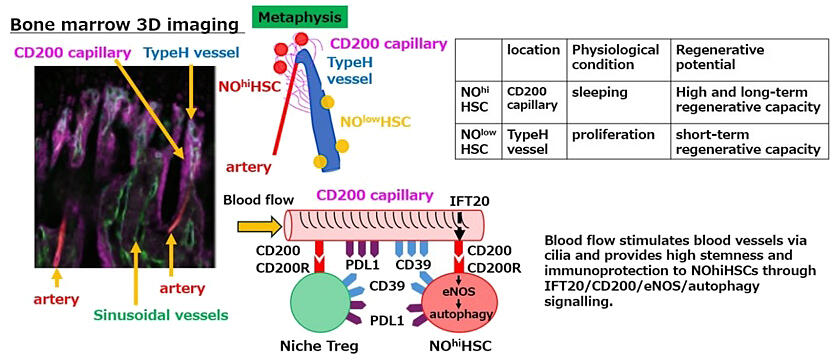Conceptually, stem cells have been known to reside in locations suitable for maintaining their regenerative potential (stem cell niches). However, it has been unknown whether the distinct stem cell niches induce differences in the regenerative potential of the stem cells present there and regulate their ability to evade attack from immune cells (immune tolerance). Lecturer Kazuhiro Furuhashi and Professor Shoichi Maruyama at Nagoya University Graduate School of Medicine, Postdoctoral Fellow Miwako Kakiuchi at Columbia University in the USA, Postdoctoral Fellow Ryosuke Ueda and Associate Professor Joji Fujisaki at Harvard University in the USA, and their colleagues have found that hematopoietic stem cells with the highest regenerative potential are mainly found in epiphyseal regions, in which blood vessels with hairpin-like structures are common, and generate high levels of nitric oxide (NO). The also found that shear stress* generated by blood flow regulates the expression of immune regulatory molecules in the stem cell niches and maintains the regenerative potential and quiescence of the stem cells themselves. The study was published in Nature.

Provided by Nagoya University
These high-level NO-generating hematopoietic stem cells are quiescent at a steady state but show high regenerative potential upon bone marrow transplantation. This study demonstrated, for the first time in the world, the presence of high-level NO-generating hematopoietic stem cells in the capillary plexuses, which are exposed to high shear stress, and the high expression of CD200 on vascular endothelial cells at these sites using three-dimensional bone marrow imaging.
Molecular analysis of these sites revealed that stimulation of the primary cilia protein IFT20, a shear stress sensor, induces high expression of immune regulatory molecules, including CD200, in the blood vessels, forming a site where the cells can evade attack from immune cells (immune privileged site). Furthermore, they found that autophagy is enhanced due to CD200 receptor-mediated NO production in high-level NO-generating hematopoietic stem cells adjacent to blood vessels highly expressing CD200 and that high regenerative potential upon transplantation and quiescence at steady state are maintained. They also succeeded in materializing the concept of the stem cell niche by visualizing it using three-dimensional bone marrow imaging via the immune molecule CD200.
In this study, they have shown at the molecular level that immune privilege and maintenance of stem cell hierarchy, which were thought to be separate functions of the stem cell niche, are linked through the immune regulatory molecule CD200. This finding provides the basis for the development from tissue stem cell regulation to tissue regeneration by regulating blood vessels and perivascular cells.
Moreover, based on the presence of similar cancer stem cells in cancer tissue with blood vessels surrounding them, the finding could also be applied to a new strategy to radically cure cancer from its upstream cells. Furthermore, the enhancement of immunoregulatory molecules in blood vessels exposed to high shear stress was shown to be involved in local inflammation control and tissue homeostasis. This finding may contribute to the development of new therapies for immunosuppression, inflammation control, and tissue regeneration.
* Shear stress: In response to liquid flowing, shear stress acts on a surface in contact with the liquid in such a way to facilitate flowing.
Journal Information
Publication: Nature
Title: Bone marrow niches orchestrate stem-cell hierarchy and immune tolerance
DOI: 10.1038/s41586-024-08352-6
This article has been translated by JST with permission from The Science News Ltd. (https://sci-news.co.jp/). Unauthorized reproduction of the article and photographs is prohibited.




